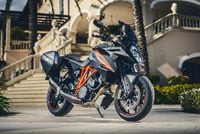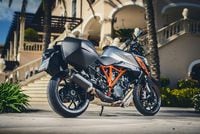European manufacturers are enthralled by electronics in motorcycles. Aprilia, BMW, Ducati—even Moto Guzzi—make digital rider aids a big part of their catalog. KTM is no different, going full high tech with the 1290 Super Duke GT (click here to read the First Ride review).
Engine The 1,301cc V-twin is largely the same as on the 1290 Super Duke R and similar to the 1290 Super Adventure's. It's a short-stroke design, with a 108mm bore and a 71mm stroke, giving moderate piston speeds at the 10,500-rpm redline. A 13.2:1 compression ratio promises both good power and efficiency, and is made possible by twin spark plugs per cylinder and sophisticated engine management software. Changes for the GT include new squish bands in the combustion chambers to improve efficiency and help the bike meet stringent Euro 4 emissions regulations.
The 75-degree V-twin uses a balancer to reduce vibration and emphasizes efficient packaging. The starter motor, for example, is nestled in the vee, while the 58mm Keihin throttle bodies are positioned to give a nearly straight shot to the intake valves. Still a dry-sump design, the 1190/1290-series engines have an integrated oil tank just ahead of the crank, eliminating the external oil lines on the 950/990 designs.
Exhaust For the GT, KTM fitted a new stainless-steal exhaust with a butterfly valve between the under-body catalyst chamber and the muffler. The can itself rides lower than on the Super Duke R, but has a joint just past the valve to accommodate aftermarket silencers. KTM says the exhaust valve improves torque delivery and helps the bike meet the Euro 4 regs.
Ride By Wire KTM continues to use a ride-by-wire scheme on the 1290 engine, and for the rider this means three ride modes: Sport, Street, and Rain. These ride modes determine engine throttle response, with Sport being sharpest and Rain being softest. The modes also change the thresholds for traction control and ABS intervention. Note that you cannot separate these functions. Sport will always have the most aggressive throttle response and the most permissive ABS and TC limits. Rain limits maximum power to 100 hp, while the other two modes allow the full 173 hp to get out.
KTM’s RBW simplifies the execution of traction control, but also makes cruise control relatively easier, which is why the GT has it stock. And, it should be noted, RBW makes meeting strict emissions regulations easier as well.
This application uses dual 58mm Keihin throttle bodies with an integral throttle servo and feedback sensors, as well as a single injector per cylinder. The system monitors throttle-grip position—the rider is really just making a request for power, not a demand—as well as things like engine speed and temperature, atmospheric conditions, gear selection, and ride mode to synthesize the ideal combination of throttle-plate position, fuel delivery, and ignition timing.
Traction Control KTM''s Bosch-sourced TC monitors wheel-speed sensors looking for differences and changing throttle angle and/or ignition timing to keep the rear tire from spinning. But it also has an IMU (inertial measurement unit) that reads chassis action in pitch, roll (lean angle), and yaw. From this information, the TC is constantly changes the thresholds of intervention.
As part of the TC, the GT’s power delivery is further tweaked by lean angle. That is, if you’re heeled over in a corner and ask for full power at the throttle grip, you’ll get only as much power as the system thinks the rear tire can handle. In this way, TC is predictive, reducing power in advance of seeing any wheel-speed differential as a way to keep the rear tire from spinning. Thresholds for this lean-angle-defined power delivery vary by ride mode, with Sport giving more freedom than Road or Rain. You can feel the system in action as you pick the bike up on corner exit. With a fixed amount of throttle input, the engine is allowed to produce more and more torque the more upright the chassis becomes. It’s a little odd at first, but you quickly become accustomed to it.
You can turn off TC completely, although it’s not a “latching” function; when you re-start the bike, TC comes on by default.
Combined ABS Not only does the 1290 GT have powerful Brembo M50 monoblock brakes it has a thoroughly up to date antilock system to back them up. KTM uses Bosch's latest Combined ABS with cornering functions. Using the same IMU inputs at the TC, Cornering ABS changes intervention thresholds—where the ABS starts working as well as how quickly it returns full control to the rider—based on lean angle. It assumes that the tires can handle less braking force the harder you're cornering, altering the thresholds accordingly.
Also, this installation has brake combining, but only front-to-rear. If you apply only the front brake, the system monitors chassis pitch and other factors to determine if a little bit of rear brake would help settle the chassis and improve stopping performance. In practice, Combined ABS is nearly transparent, with a firm, consistent feel at the front brake lever. Rarely, on our test ride, did the system add more rear brake than anticipated. Even with this combining feature, ABS is still there to prevent lockup.
ABS can be switched off completely, or you can use the “supermoto” function that retains front ABS while allowing the rear to lock.
Hill Hold Control Bosch's Hill Hold Control is standard on the GT. Basically, if the IMU sees the bike pointed uphill and the rider applies either brake, the system will maintain brake pressure for 5 seconds to allow for a smoother getaway without having to hold the brakes on manually. After 5 seconds, the system releases whether the bike is moving or not. BMW's similar system holds the brakes until the bike moves.
HHC can be turned off.
Motor Slip Regulation KTM uses two forms of anti-hopping control in the GT, a conventional mechanical slipper clutch and MSR, which opens the throttle plates slightly if the system calculates that the downshifts you're making are too abrupt to keep the rear tire from skidding.
MSR can be turned off but is deactivated when you disable the basic traction control.
Semi-Active Suspension WP's latest semi-active suspension debuts outside of the 1290 Super Adventure, using many of the same technologies. In the fork, one leg houses a spring and a travel sensor—this leg is "dry" so the sensor will not be contaminated. The other leg uses an electro-valve cartridge that provides both static damping in both directions—meaning that this is independent of the electronic control—plus variable damping as fast as 10 milliseconds. This adjustment is via a small needle valve and works on both compression and rebound. Out back, the concept is similar, with an electro valve in the body of the shock as well as electrically adjustable spring preload.
To figure out damping rates, the WP system monitors suspension travel at both ends and also watches two accelerometers to determine what the chassis is doing independently of wheel movement. As an added bonus, the GT has a system that watches rear ride height and can automatically add spring preload to level the load. It only does this once at startup; it does not dynamically adjust spring preload as you ride.
Three suspension modes are available: Sport, Street, and Comfort. Street and Comfort use the “skyhook” concept to keep the chassis level regardless of the terrain. To do so, the system tends to reduce overall damping so the wheels are free to move. But when the system detects that the bump is big enough, or that you have clamped down on the brakes or asked for full power, it increases damping rates to help maintain an ideal chassis attitude. Overall, comfort uses lighter damping rates than Street.
Sport is different in that it doesn’t use anti-dive effect—basically adding compression damping at the fork and increasing rebound damping in the shock—to help make the bike feel more natural and to allow front-end dive for the purposes of weight transfer and front-end feel. Otherwise, Sport generally uses firmer baseline damping settings and biases the ride for handling and responsiveness over pure compliance.
These suspension modes are independent of the ride modes, so you can have any combination of suspension and ride-mode schemes.
Cornering Lights As with the 1290 Super Adventure, the GT has a series of LED cornering lights in the fuel-tank leading edge that light up with increased lean angle and help illuminate the inside of the corner. The cornering lights are joined by streamlined LED front turn signals—no unsightly stalks!

















/cloudfront-us-east-1.images.arcpublishing.com/octane/G4MG6OUCJNBSHIS2MVVOTPX65E.jpg)
/cloudfront-us-east-1.images.arcpublishing.com/octane/IIGGWFOTOJGB7DB6DGBXCCMTDY.jpg)
/cloudfront-us-east-1.images.arcpublishing.com/octane/QSTCM6AVEZA5JJBUXNIQ3DSOF4.jpg)
/cloudfront-us-east-1.images.arcpublishing.com/octane/U4I7G625B5DMLF2DVIJDFZVV6M.jpg)
/cloudfront-us-east-1.images.arcpublishing.com/octane/B6XD6LS6IVCQPIU6HXDJSM3FHY.jpg)
/cloudfront-us-east-1.images.arcpublishing.com/octane/ICL63FEDDRDTTMINYICCEYGMDA.jpg)
/cloudfront-us-east-1.images.arcpublishing.com/octane/FCGZHQXRBZFLBAPC5SDIQLVF4I.jpg)
/cloudfront-us-east-1.images.arcpublishing.com/octane/WNOB6LDOIFFHJKPSVIWDYUGOPM.jpg)

/cloudfront-us-east-1.images.arcpublishing.com/octane/X33NU3E525ECRHXLNUJN2FTRKI.jpg)
/cloudfront-us-east-1.images.arcpublishing.com/octane/6KKT5NNL2JAVBOXMZYS5ZO76YA.jpg)
/cloudfront-us-east-1.images.arcpublishing.com/octane/J5RKG5O455GMPGQRF2OG6LRT7A.jpg)
/cloudfront-us-east-1.images.arcpublishing.com/octane/GX2CIZKQVRH2TATDM26KFG2DAE.jpg)
/cloudfront-us-east-1.images.arcpublishing.com/octane/ZWIDYSAKQZHD5BHREMQILXJCGM.jpg)
/cloudfront-us-east-1.images.arcpublishing.com/octane/CYUHJZCTSJCH3MRAQEIKXK7SCQ.jpg)
/cloudfront-us-east-1.images.arcpublishing.com/octane/LKOFINY56FCXJCANJ5M7ZDQUBY.jpg)
/cloudfront-us-east-1.images.arcpublishing.com/octane/4NBPDACMWJH63JQYJVK3QRBDZI.jpg)
/cloudfront-us-east-1.images.arcpublishing.com/octane/KKHQHRR3FJGX7H2IPU6RALMWG4.jpg)

/cloudfront-us-east-1.images.arcpublishing.com/octane/5IOFS5JAE5FOXMNA23ZRAVVYUU.jpg)
/cloudfront-us-east-1.images.arcpublishing.com/octane/CGXQ3O2VVJF7PGTYR3QICTLDLM.jpg)

/cloudfront-us-east-1.images.arcpublishing.com/octane/OQVCJOABCFC5NBEF2KIGRCV3XA.jpg)
/cloudfront-us-east-1.images.arcpublishing.com/octane/OPVQ7R4EFNCLRDPSQT4FBZCS2A.jpg)